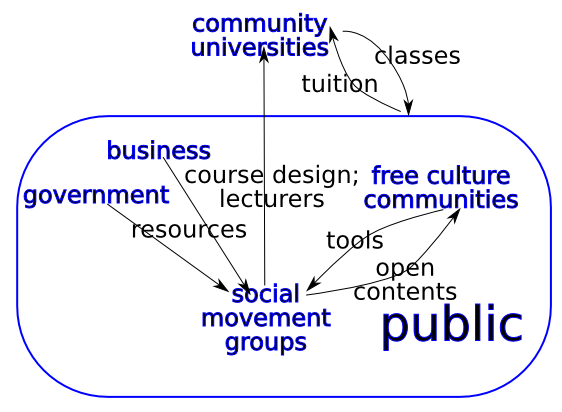Free Culture Advocacy:
A General Strategy and Some Examples
Involving Social Movement Groups and Community
Universities
| Speaker: | Chao-Kuei Hung http://user.frdm.info/ckhung/ http://ckhung0.blogspot.tw/ |
|---|---|
| Affiliation: |
Links: full article; discussions
The "Difference Set Strategy"
 What I
have learned from Free Software advocacy:
What I
have learned from Free Software advocacy:
Fighting with non-FS directly is hard;
Let's focus on the difference set:
What FS can easily do whereas non-FS cannot
intersection (difficult): office, graphics, music, ...
difference (easy): Live CD, Live USB, DRBL, ...
Strengths of Free Culture
What common strengths are shared by free software, open content, etc.?
-
Highly profitable business model?Probably not (too many). - Low cost.
- Easily multiplied. Two implications:
- Suitable for "marketing/advertizing" needs.
- Most perceivable by business who have to distribute conten/information to their customers (not selling it, but as part of their business cost).
- Remix.
Best Friends 1: Educational Institutes
- Best friends for free content consumption: Universities, schools, ...
- Why 1: Distribution is largely cost, not profit.
- Why 2: Cost is amplified by large # of "customers"
- Simplest remix: a math course using Dr. Geo, gnuplot, maxima, ...
- Remix across types of content: For a class about birds, create an enlightenment Live-CD with contents (and a theme, of course!) from wikipedia, Public Photo Gallery, Tree of Life, Freesound, ...
- Remix across courses? cross-disciplinary courses utilizing remix of open contents. (STS?)
- High-profile projects: Guadalinex, OLPC, ...
Best Friends 2: Social Movement Workers
- Best friends for free content production: organizations that advocate human rights, bikes, ...
- Why? They have an agenda to spread; they can best grasp the idea of sharing their contents as gratis publicity
- High-profile examples: Free Software Philosophy, Free Culture, gratis religious books at stations, ...
- Likely further examples:The Great Ape Project (video clips => Bonobo => Kanzi => novel sentences), An Inconvenient Truth, ...
The Big Picture (I)
 Entities are not necessarily mutually
exclusive. (E.g., free culture communities are a subset of the
social movement groups)
Entities are not necessarily mutually
exclusive. (E.g., free culture communities are a subset of the
social movement groups)- Why attractive? More conductive to the free flow of information.
- "Customer"-oriented thinking: e.g. a class for business advertisement design without legal hassles => "remix" of FS tools and open content projects such as inkscape, gimp, and wikicommons; but none of the above in great details.
- Why community universities: more flexible; affinity to communities (think marketing needs for tourism)
The Big Picture (II)
Motivations for business donations? Public perception in general, plus
- Bottomline: health insurance business => a wikibook on the health subject
- Bottomline: tourism businesses => wiktionary
- Profit: environment-friendly electronics manufacturer => green electronics purchasing policies
(Well known strategies for donation petition) The point: the marketing aspect and the amplifying effect
Why I Wrote this Article?
- FS advocates' cry: there is no lack of nice technologies;
there is a lack of public awareness -- Diffusion
of Innovation (Everett Rogers) Examples:
- Use of educational software, DRBL, and live USB at schools
- Environment-watching web sites based on map mashup
- If the police were to deploy flying webcams at dark corners where the crime rate is high...
- ...
- To free culture communities: There is a need and techniques for "marketing" free culture
- To the society (and Taiwanese in particular): technologies can be used to improve life quality, not just making money